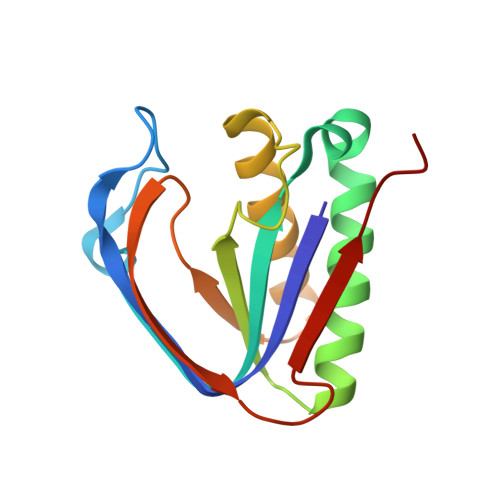Post-transfer editing mechanism of a D-aminoacyl-tRNA deacylase-like domain in threonyl-tRNA synthetase from archaea
Hussain, T., Kruparani, S.P., Pal, B., Dock-Bregeon, A.C., Dwivedi, S., Shekar, M.R., Sureshbabu, K., Sankaranarayanan, R.(2006) EMBO J 25: 4152-4162
- PubMed: 16902403
- DOI: https://doi.org/10.1038/sj.emboj.7601278
- Primary Citation of Related Structures:
2HKZ, 2HL0, 2HL1, 2HL2 - PubMed Abstract:
To ensure a high fidelity during translation, threonyl-tRNA synthetases (ThrRSs) harbor an editing domain that removes noncognate L-serine attached to tRNAThr. Most archaeal ThrRSs possess a unique editing domain structurally similar to D-aminoacyl-tRNA deacylases (DTDs) found in eubacteria and eukaryotes that specifically removes D-amino acids attached to tRNA. Here, we provide mechanistic insights into the removal of noncognate L-serine from tRNAThr by a DTD-like editing module from Pyrococcus abyssi ThrRS (Pab-NTD). High-resolution crystal structures of Pab-NTD with pre- and post-transfer substrate analogs and with L-serine show mutually nonoverlapping binding sites for the seryl moiety. Although the pre-transfer editing is excluded, the analysis reveals the importance of main chain atoms in proper positioning of the post-transfer substrate for its hydrolysis. A single residue has been shown to play a pivotal role in the inversion of enantioselectivity both in Pab-NTD and DTD. The study identifies an enantioselectivity checkpoint that filters opposite chiral molecules and thus provides a fascinating example of how nature has subtly engineered this domain for the selection of chiral molecules during translation.
- Centre for Cellular and Molecular Biology, Uppal Road, Hyderabad, India.
Organizational Affiliation:

















